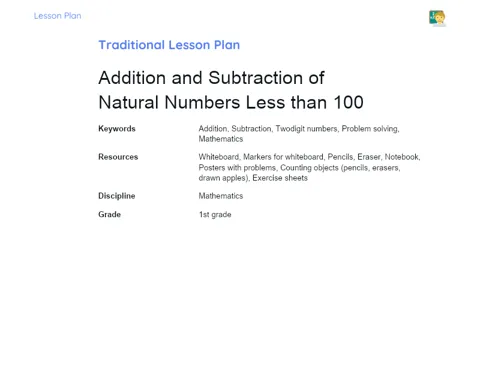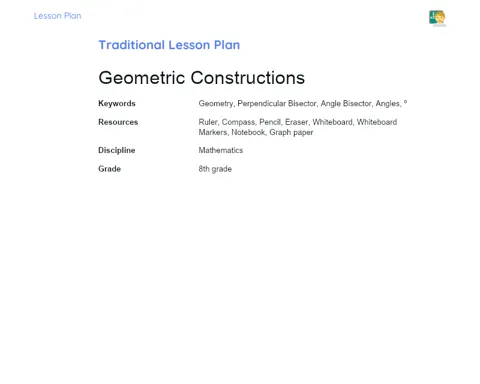Lesson Plan | Socioemotional Learning | Organization of Objects by Attributes
| Keywords | Object Organization, Attributes, Mathematics, 1st Grade of Elementary School, Self-Awareness, Self-Control, Responsible Decision-Making, Social Skills, Social Awareness, RULER, Guided Meditation, Classification, Cooperation, Emotional Regulation, Reflection |
| Required Materials | Comfortable chairs, Boxes with assorted objects (building blocks, toys, school supplies, etc.), Notebooks, Pencils, Erasers, Whiteboard, Markers, Paper slips for writing goals |
Objectives
Duration: (10 - 15 minutes)
This stage of the Socio-Emotional Lesson Plan aims to introduce students to the concept of organizing objects by attributes. The goal is to provide a solid foundation for students to identify and categorize objects according to their characteristics, while developing essential socio-emotional skills such as self-awareness and social skills. This initial moment is crucial for establishing the context and importance of the theme, allowing students to understand the practical and emotional relevance of the content to be learned.
Main Goals
1. Organize distinct objects into groups that have common attributes, such as color, material, shape, and size.
2. Develop the ability to recognize and name different attributes of objects.
Introduction
Duration: (15 - 20 minutes)
Emotional Warm-up Activity
Tranquil Journey
The proposed emotional warm-up activity is Guided Meditation. This technique is used to promote focus, presence, and concentration among students, helping them prepare emotionally for the class. Guided meditation involves closing the eyes, breathing deeply, and following the teacher's instructions while visualizing tranquil and relaxing scenarios. This practice aids in the development of self-awareness and self-control, essential competencies for socio-emotional learning.
1. Ask students to sit comfortably in their chairs, with their feet resting on the floor and their hands resting on their knees.
2. Instruct students to close their eyes and breathe deeply several times, inhaling through their nose and exhaling through their mouth.
3. Begin to guide the meditation, speaking in a calm and gentle tone. Ask the students to imagine a peaceful and safe place, such as a beach, a flowering field, or a forest.
4. Describe the scene in detail, encouraging students to visualize the colors, sounds, and smells of that place.
5. Ask students to imagine walking slowly through this place, feeling more relaxed and at peace.
6. After a few minutes, ask students to start slowly returning to the present by wiggling their fingers and toes, and then opening their eyes.
7. Conclude the activity by asking students to share how they felt during the meditation, if they wish.
Content Contextualization
Organizing objects by attributes is a fundamental skill that we use in our daily lives, often without realizing it. For example, when we tidy our toys, sort clothes by color, or organize books by size, we are applying this concept. In an emotional context, this skill helps us understand and categorize our own emotions, recognizing patterns and regulating our reactions more effectively.
Moreover, the ability to organize objects by attributes promotes the development of social skills, as it allows us to cooperate with others in group activities, respecting different perspectives and contributing to a collaborative and harmonious learning environment. By learning to classify objects, students also develop a sense of responsibility and decision-making, becoming more confident and independent in their daily actions.
Development
Duration: (60 - 75 minutes)
Theoretical Framework
Duration: (15 - 20 minutes)
1. Definition of Attributes: Explain that attributes are characteristics that can be observed in objects, such as color, shape, size, and material. Provide practical examples using objects in the classroom, such as pencils (color and size), notebooks (shape and material), and toys (type and color).
2. Classification by Color: Describe how objects can be grouped according to their colors. Use examples such as separating building blocks of different colors into different piles.
3. Classification by Shape: Show how objects can be organized by their shape. Exemplify with basic geometric shapes like circles, squares, and triangles.
4. Classification by Size: Explain the difference between sizes and how to group small, medium, and large objects. Use visual examples, such as sorting toys of different sizes.
5. Classification by Material: Discuss the different materials that compose objects, such as plastic, wood, metal, and paper. Propose activities where students can touch and differentiate the materials.
6. Importance of Organization: Explain how organizing objects facilitates daily life and helps in decision-making. Give examples of everyday situations, such as organizing a school bag or a study table.
7. Emotional Analogies: Relate the organization of objects to the organization of emotions. Explain that just as we organize objects to understand them better, we organize our emotions to understand and manage them properly.
Socioemotional Feedback Activity
Duration: (30 - 35 minutes)
Fun Classification
Students will participate in a practical activity that involves classifying a variety of objects based on different attributes. They will be divided into small groups, and each group will receive a box of assorted objects to classify. The activity will promote cooperation, decision-making, and recognition of attributes, while developing socio-emotional competencies.
1. Divide the students into small groups of 3 to 4 members.
2. Distribute a box containing different objects (building blocks, toys, school supplies, etc.) to each group.
3. Explain that each group should classify the objects according to different attributes: color, shape, size, and material.
4. Ask the groups to choose one attribute to start with and organize the objects based on that attribute.
5. After classifying the objects by one attribute, ask the students to choose another attribute and reorganize the objects.
6. During the activity, circulate the room, offering support and asking questions to encourage critical thinking and collaboration.
7. Once the activity is complete, ask each group to share their classifications and explain their choices to the class.
Group Discussion
After the practical activity, lead a group discussion using the RULER method. Start by asking students to recognize and share how they felt during the activity (e.g., excited, challenged, cooperative). Then, encourage them to understand the causes of those emotions by asking what in the activity triggered those feelings. Help them to name those emotions accurately and to express how they dealt with them during the activity.
Explain that just as we classify objects, we can also regulate our emotions by recognizing and understanding them better. Ask how they could use this skill in other situations, such as at home or with friends. This approach reinforces the importance of self-awareness, self-control, and social skills in the personal and academic development of students.
Conclusion
Duration: (20 - 25 minutes)
Emotional Reflection and Regulation
To reflect on the challenges faced during the lesson and how students managed their emotions, suggest a writing activity or a group discussion. Students can write in their notebooks about the most challenging moments they encountered during the classification activity and how they felt in those moments. Alternatively, a group discussion can be conducted where each student shares their feelings and emotional regulation strategies they used. Encourage students to reflect on questions like: 'What were the most challenging moments for you?' and 'How did you cope with those emotional challenges?'
Objective: The objective of this subsection is to encourage self-assessment and emotional regulation, helping students identify effective strategies for dealing with challenging situations. This promotes self-awareness and self-control, enabling students to recognize their own emotions and develop healthy ways to manage them, applying these skills both in academic contexts and in their personal lives.
Closure and A Look Into The Future
To conclude the lesson, the teacher can set personal and academic goals related to the content of the lesson. Explain to students the importance of setting clear objectives to continue applying what they have learned. Ask each student to write down one personal goal and one academic goal they intend to achieve. For example, a personal goal could be 'Practicing organizing my toys every day' and an academic goal could be 'Helping organize the classroom materials'. Discuss as a group about how these goals can be achieved and what steps are needed.
Possible Goal Ideas:
1. Practice organizing toys daily.
2. Help organize classroom materials.
3. Recognize and name emotions during school activities.
4. Collaborate with peers on group tasks.
5. Apply emotional regulation strategies at home and at school. Objective: The objective of this subsection is to strengthen students' autonomy and the practical application of learning, aiming for continuity in academic and personal development. By setting clear goals, students become more aware of their responsibilities and capable of applying the socio-emotional skills developed during the lesson in various everyday situations.



